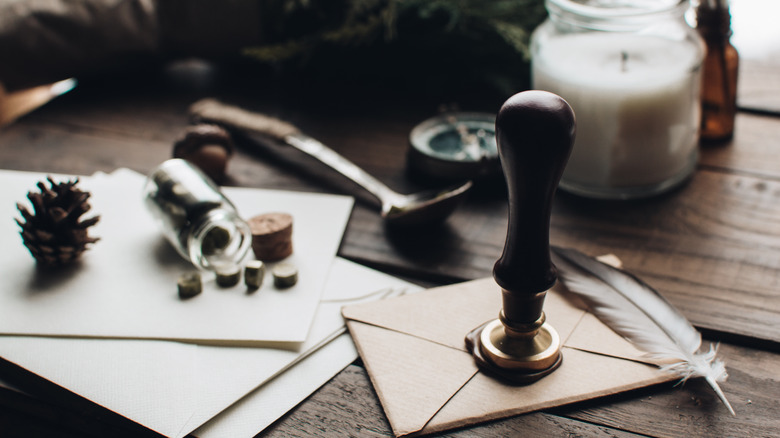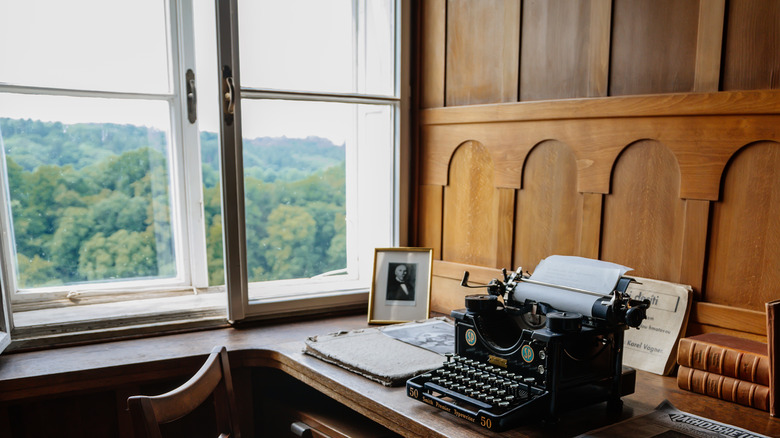What Is The Gen Z Light Academia Aesthetic?
We may receive a commission on purchases made from links.
Pull on your favorite cream cashmere sweater and get out your copy of Donna Tartt's "The Secret History," because peak light academia aesthetic season is upon us. If you're anywhere near #bookstagram or #booktok, you've probably seen #darkacademia or #lightacademia. These aesthetics — what Gunner Taylor calls a combination between "fashion sense, philosophy, a mood, and a found community" in his essay "Tweed Jackets and Class Consciousness" — spiked in popularity during the COVID-19 pandemic and have only continued to gain popularity both online and in reality.
Depop, an online marketplace, saw a 900% increase in searches for "light academia" from June to October 2020, with social media platforms like Pinterest seeing similar trends, NYLON reports. Today, there have been over 309.8 million views of TikTok videos tagged #darkacademiaaesthetic. Light academia is even more popular; the hashtag has 483.7 million views at time of publication.
Part of the appeal of the aesthetic is that it's a space anyone can enter by making an Instagram post or TikTok video, says Taylor. But the academia aesthetic isn't a utopia for everyone. One of its biggest critiques is that there's a sense of elitism and a heavy Eurocentrism, per Refinery29. In a 2021 video, YouTuber Rowan Ellis called out the academia aesthetic for its lack of diversity, especially in source material. Movies like "Dead Poets Society" and "Kill Your Darlings" are major inspirations for the aesthetic, but are also very white and very male-dominated.
Is the light academia aesthetic problematic?
For Rowan Ellis, that "idealized version of campus life" was far from her reality. She explained in her video that despite going to Durham University — a common setting of dark academia content — Ellis has never seen her experiences reflected in either light or dark academia.
Some, like TikTok users CosyFaerie, are creating content for what she's calling the "Black girl, dark academia side of TikTok," per CNN. In one of her videos on TikTok, CosyFaerie explained that this was her answer to the lack of representation of other academia aesthetic lovers who looked like them. It's not just CosyFaerie, either; Sumaiyya, a hijabi woman who runs a book club, told Refinery29 there's a lot of potential to see more diverse representation, which there is definitely a need for. "Anyone can contribute and add their own ways of seeing and experiencing dark academia," she said.
For others, the academia aesthetic's emphasis on the unattainable is kind of the point. As Gunner Taylor writes for Post45, the "reader-producers" of academia content have found a way to bypass the class barriers that once kept prestigious campuses and knowledge of art, language, and the classics by creating their campuses online.
While they may not actually walk the halls of Harvard or Oxford, Taylor adds that "dark academians" live in a "world where anyone can master the aesthetics of ruling-class belonging."
The secret history of the dark academia aesthetic
The academia aesthetic has its roots in mastering aesthetics others will tell you don't belong to you. Donna Tartt's 1992 novel, "The Secret History," is seen as the Genesis of the academia aesthetic and its subsets of light and dark. Natalie Black, director of Strategy + Insights at Hierarchy, told The New York Times that "The Secret History" isn't just a dress code, but is responsible for "transforming the entire aesthetic into an actual lifestyle."
Unlike the dreams of England and Ivy League campuses suggest, "The Secret History" actually draws its inspiration from Donna Tartt's days at Bennington College in Bennington, Vermont. Lily Anolik explains in her podcast "Once Upon a Time at Bennington College," this was where Tartt met the inspirations for Bunny Corcoran, Henry Winters, and the rest of the classics students who, at the time, dressed in light colors and vintage clothes like characters out of the 1981 PBS adaptation of Evelyn Waugh's "Brideshead Revisited."
But as Anolik points out in her podcast, Tartt never became the classics student that her main character, Richard Papen, did. Instead, Tartt pulled back the veil on an exclusive world that, at the time, was reserved only for aesthetically pleasing, wealthy, white men.
Books like "The Picture of Dorian Gray" by Oscar Wilde, "If We Were Villains" by M.L. Rio, and "A Little Life" by Hanya Yanagihara are suggested additional readings that have been growing in popularity as influences to the aesthetic.
Is there a difference between light academia and dark academia?
What Donna Tartt and "The Secret History" kicked off has morphed into a genre, whose reading lists grow by the day, as well as the internet aesthetic. "Just as Richard [Papen] enacts his attachment to his generic desires," Gunner Taylor writes for Post45, "dark academians online enact their class aspirations through the myths and rituals of education or taste."
These rituals, Refinery29 adds, are "hyper-curated and hyper-performed," that turn "an everyday activity like reading...with a cup of tea into a perform for an online audience, amped up with piano music, non-prescription spectacles, and sepia-toned filters." But whether there is a strict dividing line between "light academia" and "dark academia" remains in the hands of the user.
Even since dark academia started trending on Tumblr in 2014, the aesthetic has evolved. Ana Alsan, a dark academia content creator, told The New York Times that back then, it was all really dark, gothic, or classics-inspired photos and a lot of "written posts about what books to read."
Today, CNN declares TikTok the center of Gen Z's own takes on the academia aesthetic that often include videos of violin covers of Arctic Monkeys songs or steam billowing from a mug of tea as rain hits a windowpane in the background. There's a secretive, individualistic quality to dark academia that, in light academia, has been replaced with groups of friends in cozy bookstores and coffee shops.
How to dress in light academia fashion
Embracing the light academia aesthetic specifically means finding that sweet spot between dark academia and cottagecore. According to InStyle, this style embraces the school uniform look: structured blazers and button-downs with "sleek" trousers or a plaid skirt are a common look. But rather than going tight and short like a sexy schoolgirl Halloween costume, light academians favor loose fits and neutral color palettes.
Compared to dark academia, light academia also has what YouTuber Libby Ruth describes as a calmer, softer energy — organized good to dark academic's chaotic neutral. Amanda Brennan, Tumblr's trend expert, told NYLON that there's an "airier, less doom-focused feel that shows that knowledge brings light and happiness in the outdoors rather than a gothic darkness seen curled up in a corner."
"The androgynous vintage blazer is definitely representative for the aesthetic," Dilara Schloz, a fashion historian and researcher at Royal Holloway, University of London, told The New York Times. "It can be worn by boys, girls, and anyone who does not fit into any of these definitions. Anyone can be feminine and anyone can be masculine."
Refinery29 adds that the look is very "Smiths-era Morrissey meets 'Brideshead Revisited'" with "tweed blazers with elbow patches, knitted sweater vests, classic trench coats, Oxford brogues, and...cardigans." Sorry, no black turtlenecks here. According to The Tab, light academians do love a cream turtleneck, though — especially paired with corduroys and a blazer or sweater vest, wardrobe staples that have been trending through 2022.
The best ways to incorporate light academia into your home
The setting of your light academia lifestyle is just as important as the fashion. If you're drawn to either light academia or dark, books are probably already a major part of your life — which is good, because no matter if you're setting up your home office or dorm room in the academia aesthetic, books are going to be a key part of decorating your space, per Better Homes & Garden.
Other key players in a light academic decor are anything vintage. But as The Other Aesthetic explains, "vintage" dates back to the 18th century in this aesthetic, so churches, libraries, castles, museums, and universities decorated in Victorian, Baroque, and Renaissance styles are major inspirations. But unlike dark academia, light academia favors warm and natural lighting (via The Other Aesthetic). Bright candles and sunlight are encouraged here.
The suggested color palettes for light academia decorating are, of course, nature-inspired and natural: soft creams, yellows, and greens. Better Homes & Gardens suggests putting your vintage typewriter on display and hanging some retro botanical prints on the walls if you're looking to dip your toes into decorating with the light academia aesthetic. House Digest recommends adding amber glass accents, like a vase with dried Amaranthus, to "give your room the feeling of a cabinet of curiosity."
Clocks are another great decoration piece, says The Other Aesthetic, as well as mirrors, antique tea sets, globes, instruments, and framed vintage postcards.





